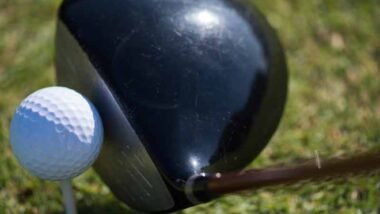Is your golf game suffering because of a slice? A slice can be frustrating, but you’re not alone—many golfers face this issue. Fortunately, there is a simple drill to fix a slice fast. There are also techniques that can help you improve your swing and fix that slice quickly as well. Let’s take a closer look at why slicing happens and how you can turn your game around.
Understanding the Slice
Before you can fix your slice, it’s essential to understand what it is. A slice is when your ball curves dramatically to the right (for right-handed golfers) during its flight. This often occurs due to an open clubface at impact or an improper swing path. Knowing the root of the problem is the first step toward making a successful correction.
Why Does a Slice Happen?
There are a few primary reasons why you might be slicing the ball:
- Open Clubface: If your clubface is pointing towards the sky at contact, it can impart sidespin on the ball, causing it to slice.
- Out-to-In Swing Path: This occurs when your club travels from outside the target line to inside at impact. This path, combined with an open clubface, can lead to a slice.
- Poor Grip: A weak grip (where your hands are turned too far to the left on the club for right-handed golfers) can also contribute to an open clubface at impact.
- Body Alignment: If your shoulders, hips, or feet are not aligned correctly, it can affect your swing path, leading to a slice.
Understanding these causes will help you focus on the right solution.
Simple Drills to Fix a Slice
Now that you know the potential reasons for your slice, let’s jump into drills that will help you address these issues effectively.
Drill 1: The Clock Drill
The Clock Drill is a fantastic way to practice your swing path.
- Setup: Imagine a clock face. Place tees at 10 o’clock, 12 o’clock, and 2 o’clock relative to your stance.
- Practice Swings: Make swings focusing on hitting the teed ball at these positions.
- 10 o’clock encourages an inside path.
- 12 o’clock is for straight shots.
- 2 o’clock reinforces a proper follow-through.
- Focus on Swing Path: Ensure your club moves from the inside to the outside of the ball as you swing.
By practicing these positions, you’ll train your body to create a more shallow and consistent swing path.
Drill 2: The Alignment Stick Drill
This drill is great for improving your alignment and understanding the correct swing path.
- Tools Needed: Grab two alignment sticks or any straight objects like rods.
- Set Up the Sticks: Place one stick on the target line and another parallel to it so that it points directly at your ball.
- Stance: Stand behind the sticks and visualize how your body should align with them.
- Practice Hitting: Make several practice swings, focusing on keeping your club inside the alignment stick and following through without cutting across the ball.
This drill will help you develop a better sense of where you should hit the ball relative to your body’s alignment.
Drill 3: The Grip Drill
As previously mentioned, your grip can play a significant role in slicing. This drill will help you strengthen your grip and promote better clubface control.
- Grip Check: Start by checking your grip. For right-handed golfers, ensure your left hand is gripping more on top of the club rather than on the side. Your right hand should overlap or interlock and have some control over the clubface.
- Hold the Club: While holding your club with the correct grip, turn your palms to face each other.
- Swing Practice: Make some half swings while maintaining this grip. Focus on your wrist movement, ensuring the clubface remains square at impact.
Practicing with the correct grip can significantly influence the shot, reducing the chances of slicing.
Drill 4: The Release Drill
Your follow-through and the way you release the club can help eliminate a slice.
- Setup: Take your normal stance. Make sure your feet, hips, and shoulders are aligned correctly.
- Practice Release: As you swing, focus on releasing the club—allowing the club to rotate through impact. This helps to close the clubface at contact.
- Half Swings: Start with half swings until you get comfortable, then gradually increase to full swings while maintaining the correct release.
Trying different levels of release during your practice will lead to more consistent shots.
Improving Your Swing Path
Focusing on fixing your slice is intertwined with improving your swing path. Here are some key points to consider:
Understanding Swing Plane
Your swing plane is the angle at which you swing the club. A correct swing plane ensures the club travels in a straight line towards the target.
- Posture: Ensure your posture is athletic, with your knees slightly bent and your back straight. This helps in maintaining a proper swing plane.
- Practice Drills: Use golf teaching aids, like a weighted club or swing trainers, to feel the difference in your swing path.
The Importance of Hip Movement
Your hips should rotate during your swing to maintain a natural motion.
- Hip Rotation: Practice rotating your hips during the backswing and downswing, leading to a more powerful club release.
- Drill: Stand against a wall with your back. Swing your arms while ensuring your hips pivot, preventing any slicing due to improper hip movement.
How to Train Your Mind
It’s not only about the physical aspect; training your mind can also greatly impact your ability to fix a slice. Here’s how you can improve your mental game.
Visualization Techniques
Visualization can be a powerful technique in golf. Before hitting a shot, visualize the desired flight of the ball.
- Picture the Shot: Close your eyes and visualize your swing without a slice.
- Imagery Practice: Imagine the ball’s trajectory and how you want it to curve. The clearer the image, the more likely you are to execute it.
Positive Self-Talk
Replacing negative thoughts with positive affirmations can enhance your performance.
- Affirmations: Use phrases like “I hit straight shots” or “I control my swing path” to build confidence before you tee off.
- Routine: Develop a pre-shot routine that includes calming breaths and positive affirmations.
Putting It All Together
After practicing these drills and improving your mental approach, you’ll want to put everything together during your practice rounds.
Create a Practice Plan
Structure your practice into specific segments focused on each area (grip, swing path, mental game).
| Focus Area | Drill or Technique | Time Allocation |
|---|---|---|
| Grip | Grip Drill | 15 minutes |
| Swing Path | Clock Drill | 15 minutes |
| Alignment | Alignment Stick Drill | 10 minutes |
| Hip Movement | Hip Rotation Drill | 10 minutes |
| Mental Game | Visualization & Self-Talk | 10 minutes |
By systematically focusing on these areas, you can steadily improve and notice changes in your game.
Incorporate Feedback
Consider getting feedback by recording your swing or working with a coach. A perspective can identify any adjustments necessary to fix a slice at its source.
Track Your Progress
Keeping track of your progress will help you see improvements over time.
- Journal: Maintain a golf journal detailing your practice sessions and any changes you detect in your swing.
- Performance Metrics: Focus on metrics like how often you slice the ball or your average score. This data will give you insight into your overall progress.
Regular Maintenance
Fixing a slice isn’t just about one practice session. Maintaining your improvements requires ongoing focus and drills.
Periodic Review of Your Grip and Alignment
It’s easy to revert to old habits, so regularly checking your grip and alignment before each round can prevent slices from creeping back in. Each time you practice:
- Review your grip as you settle in.
- Check your alignment with an alignment stick before every shot.
Consistent Practice
Make a habit of working on these drills regularly. Even short, focused sessions can solidify your improvements over time.
- Allocate Time: Create a dedicated practice schedule for your golf sessions.
- Small Goals: Set small, achievable goals for each session, gradually working toward eliminating your slice altogether.
Conclusion
Fixing a slice may take time, but with commitment and dedication to practice, you can certainly overcome this challenge. Try incorporating these drills into your routine, focus on your swing path, work on your grip, and maintain a positive mindset. Remember, golf is as much a mental game as it is a physical one. Track your progress and make adjustments as necessary, and you’ll be well on your way to hitting straighter shots and enjoying the game even more. Good luck, and happy golfing!







